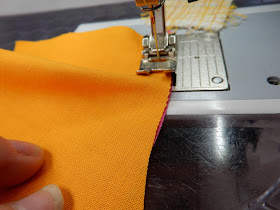Check these out too...
▼
Thursday, May 17, 2018
Quiltmaking 101 -- freehand and curved seams 2
If you have chosen to cut your quilt pieces freehand instead of using a ruler, or if you are deliberately using curved seams, you face a construction issue: how to make the finished seams lie perfectly flat. If the curves are gentle -- think the profile of a watermelon -- and if they curve in the same direction, you can usually just sew one to the other and they will be fine.
This approach works as a new construction method if you layer two pieces of fabric on top of one another, then cut a gentle curve through both layers. Swap the pieces and stitch them together.
The piece above was made with three cuts, not one, and of course it yielded a mirror image piece with the same curves but the opposite color arrangement. Note that the middle seam ended up wonky, with the black quite a bit longer than the orange, even though they were presumably the same length to start with. This is not a failure of sewing skill; it's an unavoidable and unpredictable result of the process of sewing two bias edges together.
When this happens to you, and it will, don't feel guilty, don't try to rip the seam and redo it, just trim off the edge.
The just-sew-it approach also works with random pieces that you may find in your stash and want to sew together. As long as the curves have approximately the same radius, and point in the same direction, you'll probably be fine. But if they point in opposite directions, or are too radically different in profile, you'll end up with bulges or clots. Plan ahead, and don't do that.
These pieces will most likely go together beautifully.
These pieces won't.
With gentle curves the actual sewing will be very much like holding straight edges together -- no big deal. But when you sew more pronounced curves -- as the watermelon profile becomes more like a cantaloupe or a grapefruit -- it's harder to maintain the proper seam allowance because the two edges are so different in profile: one a distinct hill and the other a valley. It will be easier if you hold the "valley" curve on top and the "hill" on the bottom, even though that makes a lousy mnemonic.
Establish the seam allowance at one end of the seam and put your needle down through both layers. If possible, set your machine so it automatically stops with the needle down, to make sure the pieces don't slip out of alignment when you stop to reposition the fabrics. Carefully align the edges of the two layers and stitch for maybe a half inch. Stop needle down, and reposition the fabric.
Make sure you can see the edge of the under layer, because it curves away from the needle and if you're not careful you can sew right off its edge. If you stitch with a hint of pink peeking out from under the yellow, you'll be fine. Yes, this is slow going, but this is how you get a perfect seam.
The top layer will form ruffles behind the needle as you stitch around the curve. Don't pull tight on the top layer as you hold it in position; if anything, ease just a bit of extra fabric into the curve as you sew.
After you get to the end of the seam, flip it over and check whether you have inadvertently sewed any pleats into the bottom layer of fabric that you couldn't see. If you have, get your seam ripper and open the seam for a quarter inch on each side of the pleat. This time sew with the "hill" side up so you can watch carefully as you ease the fabric under the needle and get it smooth this time. It's important to fix any glitches before you press, while the fabric is at its most flexible.
Sometimes you'll sew curved edges together, press the seam, and it looks as though everything is perfect. But when you flip back to the right side, you'll notice that the two edges didn't match perfectly. When you turn that curved seam over, run your fingernail along it from the downhill side to find any hidden pleats.
If you find one, don't worry -- it's very easily fixed. Turn it back to the wrong side and notice that the iron has creased the fabric at exactly the right place to give you your perfect seamline. Restitch the seam along the crease mark and the curve will look exactly as it did before, except the new stitching will have closed the pleat.
Looks great from the front, but....
....there's a huge gap at the end of the seam between black and yellow.
Go back and stitch exactly on the crease line.
You will note that all the curves in this post go in one direction only -- no S-curves or multiple-winding roads. If you want to sew these more complex curves, you'll need a more precise method to make them lie perfectly flat; stay tuned for the next tutorial.
And then there will be more about pressing curved seams in a further installment of Quiltmaking 101. Wait and read that before you take your seam to the ironing board.









WOW...thanks...I've always thought I was doing something wrong when having that little leftover edge! Thanks for the tips!!!
ReplyDeleteGreat tutorial....so clear with matching photos!
ReplyDeleteLooking forward to S curves.
Thanks! I have had difficulties with curved seams!
ReplyDelete